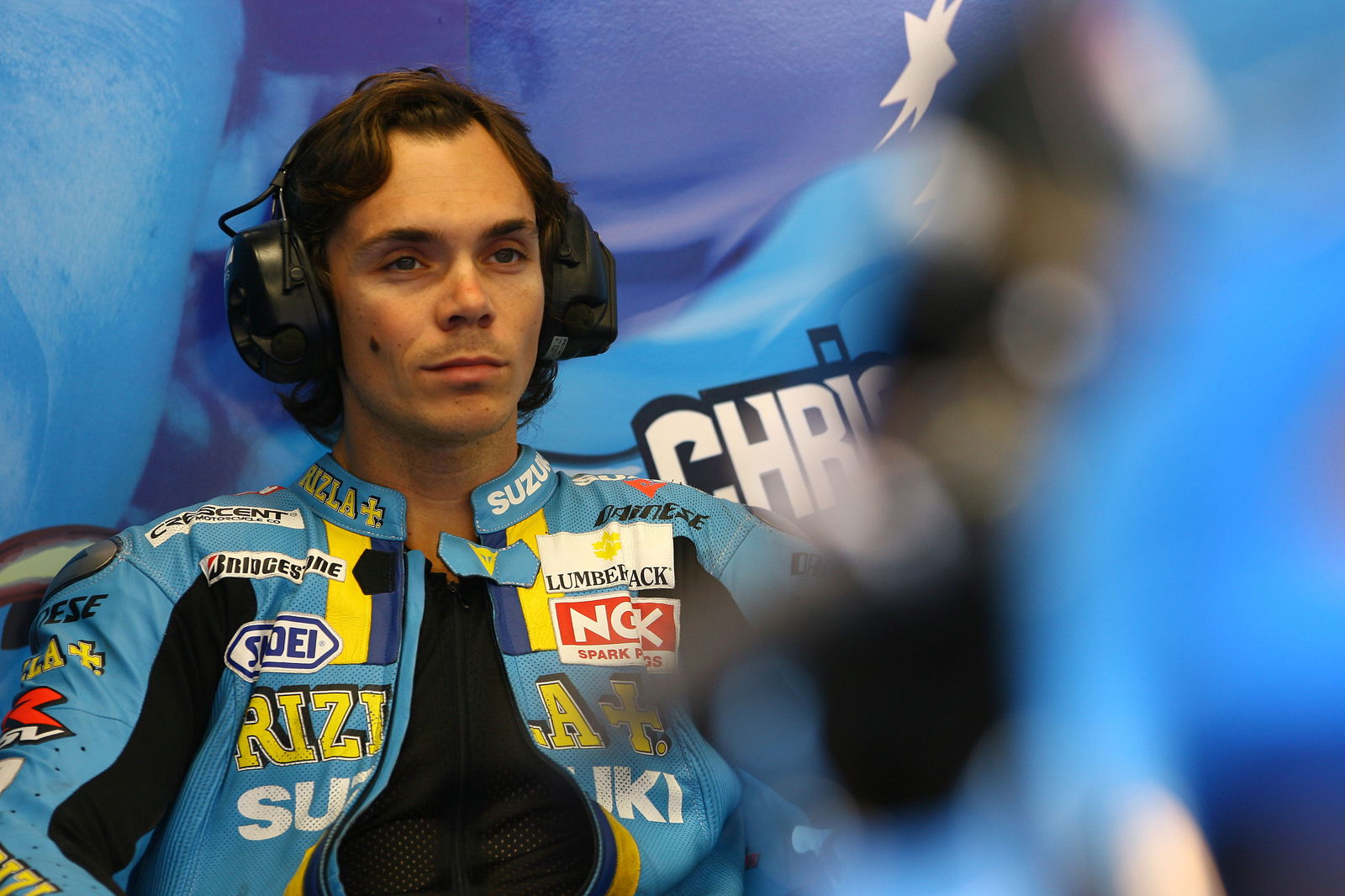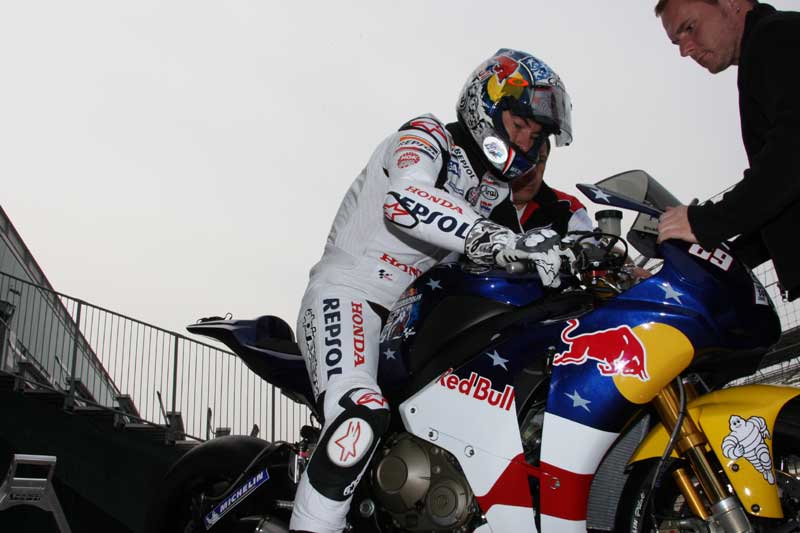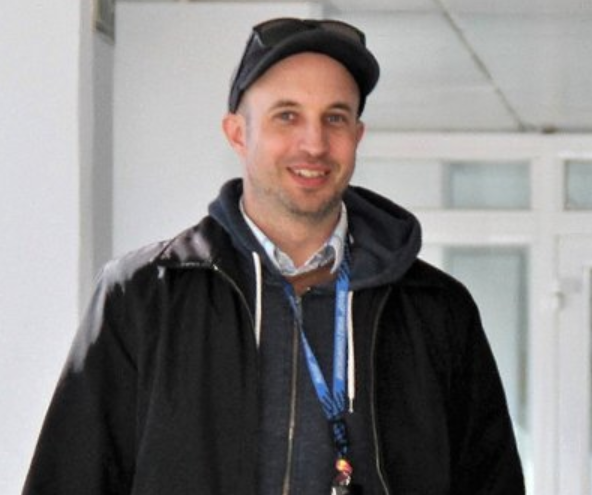Q&A: Dani Pedrosa`s suspension technician.
Manuel Olivencia is Dani Pedrosa's Showa suspension technician.

Manuel Olivencia is Dani Pedrosa's Showa suspension technician.
2008 is Olivencia's third season in MotoGP, although he first worked with Honda back to 1998, when he was a member of the Showa racing department in the World Superbikes Championship - working with Colin Edwards and Aaron Slight.
Olivencia began working with Pedrosa in 2005, when the Repsol Honda rider was still in the 250cc category. Pedrosa was the 2006 MotoGP rookie of the year, finished second in the 2007 world championship and is currently joint second in the 2008 standings heading into this weekend's Italian Grand Prix...
Q:
First, tell us about how you got here. When and how did you start out in the world of motorcycling?
Manuel Olivencia:
A long time ago. My father was a professional motocross rider, and he later went on to be a mechanic at the world championship, so I've been to circuits since I was small. Then I started in Showa, carrying out tests at the prototype department and getting to know how suspensions work in depth. At the end of '98 I started in the Superbike racing department, with Colin Edwards and Aaron Slight. I spent three years there, and in 2002 I returned to the factory, carrying out tests in the development department. In 2003 and 2004 I went back to Superbikes with Gregorio Lavilla, Chamb?n and Fujiwara. Then, in 2005, I started to work with Dani in 250cc, up until today.
Q:
Can you describe what your job is like over a race weekend?
Manuel Olivencia:
We generally get to our destination on Tuesday night. On Wednesday morning, at around half eight, we get to the circuit and set up the truck, which is the base where we work, our mobile workshop. In the afternoon we get down to some office and paperwork, and have a meeting with the chief mechanic -Mike Leitner- and the rest of the team, where we comment on how the grand prix may develop and think about all the possibilities we could try out. We decide on what will go out and race on Friday. On Thursday we do the more mechanical side of things, which is preparing the suspension. On Friday the training sessions kick off and we fine tune what we'd prepared with comments from the rider.
Q:
Do you use data from previous years? What references do you start off with?
Manuel Olivencia:
It depends mainly on the development during the current season, and the trend coming from the previous race, while always backed with data collected from previous years. Mainly for the problems that might arise and to always be prepared, because in an hour of training the reactions have to be very fast, you don't have time to try out a lot of things. That's why in this meeting we try to anticipate any possibilities, to be as prepared as possible for any situation.
Q:
How many suspension units do you have for each race?
Manuel Olivencia:
We have three forks and three shock absorbers ready for each rider, apart from all the possible spares we have in the truck. What's more, every few kilometres we do what's called a complete service, which means completely dismantling the fork or damper, changing all the friction joints, valves, oil, etc. It's all revised and left as good as new.
Q:
Everyone knows what a shock absorber is, but, broadly speaking, how does it work and what are its most important elements?
Manuel Olivencia:
Basically a shock absorber is composed of two groups, a spring and a hydraulic part. The part with the spring is what holds the weight of the bike, gives it its position, and the hydraulic part - which is the inserted rod - counteracts the force of the spring.
Q:
How psychological is your job? There is always talk about riders who, on specific occasions, have more need for that fictitious 'click' in their suspension than real changes to the adjustment...
Manuel Olivencia:
In my experience I haven't had riders who needed a 'psychological click'. Well, I had a Japanese rider who always needed something done when he was on the grid. But it's generally not the case. Today - I've been with Dani a few years now - you see that the more confident the rider feels, the less psychology he needs. If he need a click, it's because he really needs it to improve the bike, I don't believe in a psychological click, though it may possibly be the case with some riders. It is not with Dani. What's more, at 330 km/h you can't play around with psychology much. They're professionals who know what they have, what they want and what they need.
Q:
Are there any circuits that are particularly critical in terms of suspension due to rough surfaces or other circumstances? Also, how many shock absorbers would you fit and remove during a grand prix weekend?
Manuel Olivencia:
No, there aren't any particularly terrible, or on the other hand, particularly good circuits. You can find circuits where the effect of the Formula 1 cars or the trucks is evident, because they are obviously more uneven. But currently I think that the grip is the most important aspect, as it is where the transfer of power from the bike occurs, through the tyres. The grip is what gives you a good idea of the reactions of the bike, if not, it's as if nothing was working and you lose the confidence of riding comfortably and fast.
Q:
What is Dani Pedrosa like when setting up a bike, particularly the suspension? Is Dani a rider who communicates his feelings on track and the performance of the suspension with precision?
Manuel Olivencia:
First of all, Dani is a very intelligent rider, and second, he knows how to communicate what he feels on the bike at all times. Everything he says when he gets off the bike is what is really happening to him; he's very sensitive and precise. What's more, in my opinion he's a rider who apart from being intelligent, is capable of making our job easier through his work, because he adapts very easily and knows that if there are unavoidable problems, he won't focus on them but on what really can be improved. For example, if you're on a circuit and there's a bend where, for whatever reason, the adjustments are terribly inappropriate, he knows how to dismiss the feelings in that bend because he knows how important it is to have the maximum performance on the rest of the track. He knows how to find the best compromise for the bike, because making a perfect bike is impossible.
Q:
What would you highlight as his best quality?
Manuel Olivencia:
He has many, but it's probably his consistency. I call him 'the swiss watch', because when during a training session we see that, if all goes well, he always runs the same times in every partial, it's not that he improves by a tenth in one lap, then climbs two more, and varies his performance. He doesn't constantly fall behind or jump ahead.
Q:
Which rider has impressed you the most as far as feedback during your professional career?
Manuel Olivencia:
I think it's Dani. Because we sometimes carry out tests with new material, which other riders have already tried out, and he makes comments which no one else has made, or is aware of things that seem hard to pinpoint with such precision. For example, I remember that in Brno 2005, we tried out some bars that had a different treatment which had never been used before in 250cc, though in MotoGP other riders had actually tried them out, for example Valentino Rossi, Colin Edwards and many more people. Everyone always agreed with their comments, but Dani added a comment giving a point of view which I, who had heard the comments from the others, found very surprising. It was a question of friction, and everyone felt that it was a much smoother and easier fork to move, while Dani added that the uphill chicane before the finish line was so smooth, that to the contrary, he couldn't feel the wheel properly. Nobody had made that negative comment about how smooth that fork was. In many situations, he notices the slightest changes, and that's not easy and doesn't cease to surprise me.
Q:
How do you save a situation where rain arrives on Sunday and there has been no prior wet practice? In those situations are the adjustments a bit of a lottery...
Manuel Olivencia:
No, it's not a lottery. As I said, before the race we prepare for the situations that may arise during the weekend, and have adjustments ready for wet conditions. So we don't leave anything to a 'let's see what happens' lottery, but depending on the number of times we've run in wet conditions, we draw conclusions which give us a starting point. When Sunday arrives and you haven't done any training, you have to fit something that, while not perfect, has a precedent. No lotteries at all.
Q:
Has the latest version of the Honda RC212V 2008 made your job easier with respect to the previous version?
Manuel Olivencia:
Maybe a bit. I think the package itself is slightly better. I think overall the bike is more compact, more of a racing bike, and probably a bit easier. Last year's bike was much more critical when both braking and accelerating. Now it's more suited to our style.
Q:
Could you give us your opinion on how suspension has changed in the premier class, from 500cc to 990cc and then 800cc?
Manuel Olivencia:
Basically, the suspension has always worked the same way: a fork or a shock absorber and a few springs, oils, dampers, etc. It doesn't vary that much. The 500cc's were lighter than these [800cc] bikes and the 990cc's were heavier. Furthermore, with the four-stroke engine, engine braking also has a big influence, though we didn't have to look for anything different. The delivery of power with the four-stroke engine and traction control are quite different, so in the rear end there has been more development, in order to deliver power to the tyre more efficiently than before. As for the front end we've been making and testing new stuff, but if we still had the 500cc's, the fork would definitely be the same.
Q:
It has been some time since there was serious talk about the dreaded problem of 'chatter' in the paddock. Is serious 'chatter' dead? Has the suspension technicians' nightmare disappeared? Can you explain what caused this 'chattering'?
Manuel Olivencia:
'Chattering' was an internal vibration produced between the tyre and the bike. I don't think it has disappeared, in fact with telemetry we can see it exists, but here you need what I said earlier about an intelligent rider like Dani, who knows well that there are problems that won't be solved and others that will be, and knows that a particular solution might complicate things, so he chooses to leave it as it is and gets used to it. As soon as the bike starts moving, some riders say they have chatter, and there are people who can't tell the difference; until it became fashionable for a while as the cause of every single problem, even when you didn't know what was happening. With telemetry sometimes you can really see it happening, and you try to solve it. But it so happens that there are riders who don't think it's worth wasting so much time on this issue. Everyone always recalls Biaggi - chatter drove him mad.
Q:
How do you solve a 'chatter' problem?
Manuel Olivencia:
It depends on when it happens, if it's opening up the gas, braking, not braking... Depending on where it happens you can play it one way or another. But always without going crazy about it, for the same reason we commented earlier: if on the rest of the circuit it's doing fine, and at a particular moment you feel a vibration, you can't sacrifice the rest just to overcome that problem. You have to know how to discriminate and evaluate, and Dani knows well how to do that.


